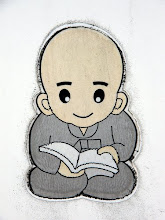Sakyamuni Buddha taught three "Dharma seals", or criteria, to determine the genuineness of Buddhist teachings, namely impermanence, suffering, no-self. A fourth criterion, emptiness, is also mentioned in the sutras. Thus, the Truth of Impermanence is basic to Buddhism... After seeing a corpse, the young prince Siddhartha (Sakyamuni Buddha) decided to leave the roya life to become an ascetic.
On the Truth of Impermanence, see the following passage by Red Pine:
Shakyamuni left home to find a way out of the endless round of life and death. Anyone who follows the Buddha must do the same. When it was time to transmit the robe and bowl of the Zen lineage, Hung-jen, the fifth Zen patriarch, called his disciples together and told them, "nothing is more important than Life and Death, you spend all your time looking for ways to earn merit. If you are blind to your own nature, what good is merit? Use your wisdom, the prajna-nature of your own mind. All of you, go write me a poem." (The Zen Teaching of Bodhidharma, note 20.) An interesting corollary of the concept of Dharma seals is that much of the current speculation about whether or not this or that sutra is genuine is, in a sense, moot. A sutra is a sutra because it contains the words of the Buddhas or because the ideas expressed in it conform to the Dharma seals. An example of the latter is the Platform Sutra, which records the words of the Sixth Patriarch of Zen.
An interesting corollary of the concept of Dharma seals is that much of the current speculation about whether or not this or that sutra is genuine is, in a sense, moot. A sutra is a sutra because it contains the words of the Buddhas or because the ideas expressed in it conform to the Dharma seals. An example of the latter is the Platform Sutra, which records the words of the Sixth Patriarch of Zen.
On the Truth of Impermanence, see the following passage by Red Pine:
Shakyamuni left home to find a way out of the endless round of life and death. Anyone who follows the Buddha must do the same. When it was time to transmit the robe and bowl of the Zen lineage, Hung-jen, the fifth Zen patriarch, called his disciples together and told them, "nothing is more important than Life and Death, you spend all your time looking for ways to earn merit. If you are blind to your own nature, what good is merit? Use your wisdom, the prajna-nature of your own mind. All of you, go write me a poem." (The Zen Teaching of Bodhidharma, note 20.)
 An interesting corollary of the concept of Dharma seals is that much of the current speculation about whether or not this or that sutra is genuine is, in a sense, moot. A sutra is a sutra because it contains the words of the Buddhas or because the ideas expressed in it conform to the Dharma seals. An example of the latter is the Platform Sutra, which records the words of the Sixth Patriarch of Zen.
An interesting corollary of the concept of Dharma seals is that much of the current speculation about whether or not this or that sutra is genuine is, in a sense, moot. A sutra is a sutra because it contains the words of the Buddhas or because the ideas expressed in it conform to the Dharma seals. An example of the latter is the Platform Sutra, which records the words of the Sixth Patriarch of Zen.
No comments:
Post a Comment